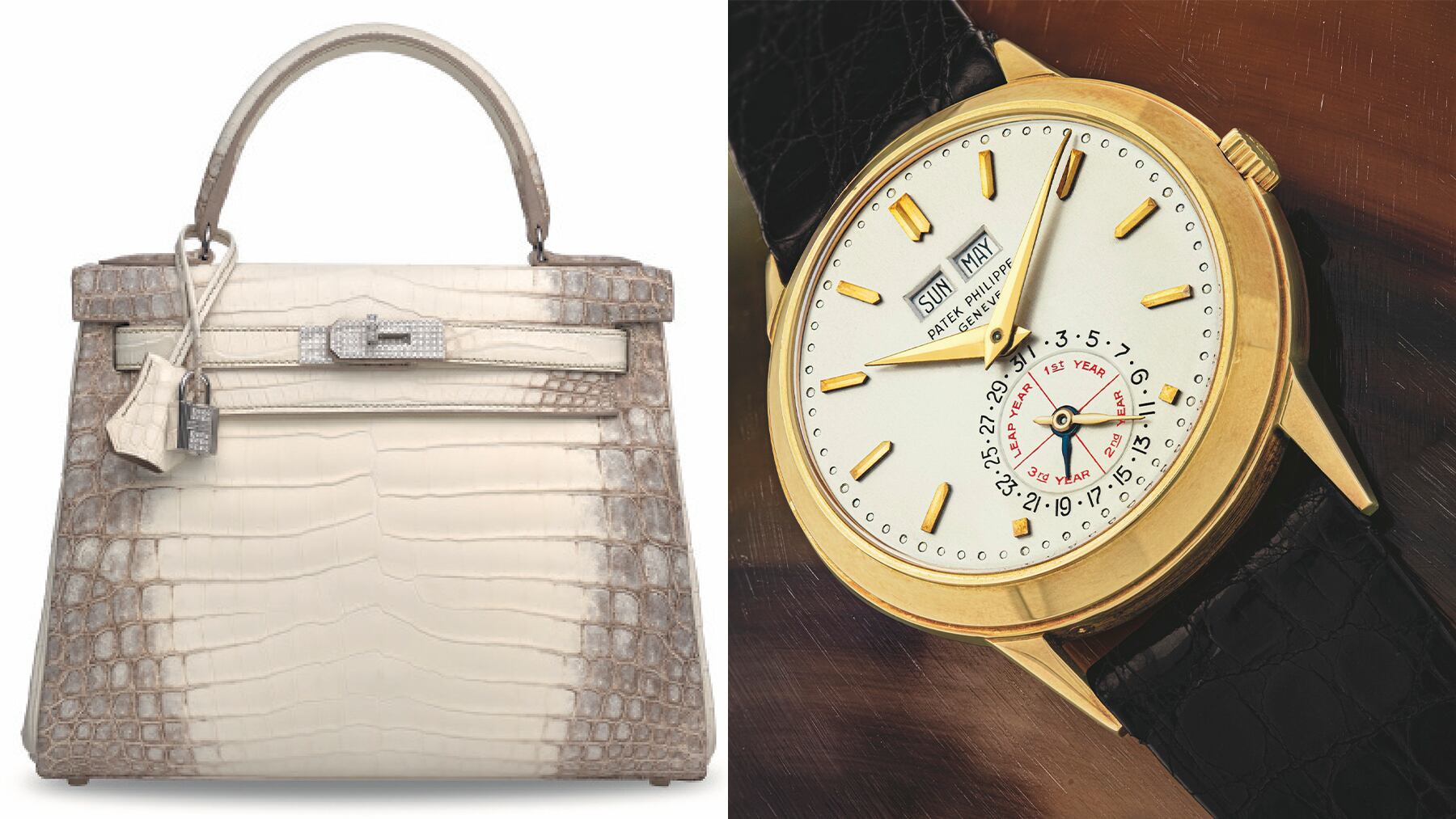What’s Driving the Luxury Auction Boom?
- Christie’s luxury sales more than doubled last year, growing 153 percent to $980 million.
- Hermès continues to dominate the market for fashion auctions, including Christie’s world-record sale of a Himalaya Diamond Kelly bag for $515,000.
- Christie’s and Artcurial are targeting clients beyond traditional auction capitals, holding events in Aspen, Southampton and Monaco that helped fuel success.
The importance of luxury goods to the world’s top auction houses continues to climb.
Christie’s reported that its sales of luxury goods including jewellery, watches and handbags more than doubled last year, surging 153 percent to $980 million.
In 2021, the auction house, which is owned by Kering founder François Pinault and better known for its sales of artworks by Modigliani and Damien Hirst, generated $736 million through its live auctions (in-person and online), while the remaining $240 million in revenue were made via its burgeoning private sales business, which includes an online marketplace as well as discreetly connecting sellers with its roster of wealthy buyers behind the scenes.
Record-breaking sales included the highest price ever recorded for a handbag — an Hermès Himalaya Diamond Kelly that sold for $515,000 — as well as booming prices for rare timepieces, including the sale of a Patek Philippe desk clock for $10.4 million.
Luxury items also continued to gain traction at Paris auction house Artcurial. Last year they made up 18 percent of 169 million euros ($193 million) in total sales, up from 10 percent of sales in 2019. Sotheby’s, too, now sells Hermès Birkins and special-edition Louis Vuitton X Yayoi Kusama Keepall bags alongside its listings of paintings by Mark Rothko and Cy Twombly.
What’s driving the increased activity in luxury auctions?
While luxury watches and jewels have long been a pillar for auction houses, the increased activity in second-hand fashion might be surprising as it comes amid rising competition for both customers and suppliers. Online luxury resale platform Vestiaire Collective raised an additional $210 million to fund its expansion last September, pushing its valuation to $1.7 billion. Rebag and GOAT also announced successful funding rounds.
Younger, Digitally-Savvy Clients
One reason the sellers of $162 million Modiglianis would busy themselves with $2,100 Cartier Trinity rings is that they see luxury goods as a key acquisition tool for reaching younger clients and for growing their businesses online.
For younger buyers with a “strong lens on sustainability,” luxury auctions allow them to balance instant gratification with sticking to their values, all while “fulfilling the wish to obtain an object of great rarity,” Christie’s Americas president Bonnie Brennan said.
While auctions for traditional categories like art are still dominated by older generations, millennial buyers accounted for 29 percent of luxury sales at Christie’s and as high as 43 percent for luxury handbags and accessories. Among luxury buyers, 32 percent were new clients.
The ease of shipping and storing luxury items, and a high comfort level with e-commerce in the category also makes it ripe for online expansion. That’s been pivotal for auction houses since the pandemic, as travelling or sending representatives to auctions around the world has been more complex. An online-only handbag auction at Christie’s brought in $4 million last November, while other digital wins included the sale of a Patek Philippe Sky Moon watch for $1.6 million.
While resale sites like Vestiaire Collective offer second-hand luxury goods up for straightforward consumption, auction houses are well-positioned to curate the items and spotlight their rarity or provenance, positioning them as collectables for would-be acquirers.
Auction houses can also drive interest in less broadly sought-after brands by creating a thematic link among objects in a sale, such as Christie’s “La Dolce Vita” Italian jewellery event or its annual “Handbags and Hype” sales focused on limited editions, which combine collector-grade luxury handbags with rare items from streetwear labels like Supreme. “We’re always thinking about the opportunity to tell great stories,” Brennan said.
Hermès Continues to Drive Growth
Still, one name continues to dominate interest in luxury fashion auctions. “Hermès is really the king or queen in this space,” Brennan said.
Many luxury clients don’t want to endure long waiting lists for the Paris brand’s Birkin and Kelly handbags, for which demand has long exceeded supply. Nor are they interested in buying thousands of dollars in other items in the hopes of speeding along their relationships with sales associates who hold the keys to the sought after products. Those shoppers are willing to pay a steep premium to get an Hermès bag now, even if it means going through the secondary market.
As awareness of the second-hand demand has grown, so has the quantity and quality of supply: shoppers who manage to get their hands on Hermès’ best-selling bags know they can be compensated handsomely at resale. They’re more likely to safeguard packaging and authenticity certificates, and to keep them in pristine condition.
“If you want to do a bit of speculation, it’s the only brand that can resell higher than the original price. The desirability is both incredible and inter-generational,” said Alice Léger, who heads Hermès sales for Artcurial. Average prices for Hermès spiked this year along with sales volumes, Léger said, with one bag estimated at €6,500 even going for as much as €35,000.
As with Hermès, supply shortages for new items helped drive interest in vintage watches last year, with a run on Patek Philippe and Rolex watches in stores bringing more buyers than ever to the secondary market.
Following the Money
Auction houses also saw success selling luxury items by shifting their activity from global capitals to smaller havens for the wealthy.
Christie’s followed the trend of luxury brands staging resort pop-ups, hosting its own events in Aspen, Southampton and Palm Beach.
In recent years Artcurial’s special sales in Monaco have been a key driver of growth. The house’s “Auction Week” in the Mediterranean principality in July brought in €21.5 million. “It’s a microclimate of luxury,” Léger said.

:quality(70)/cloudfront-eu-central-1.images.arcpublishing.com/businessoffashion/L2NT5A23ARD7TAXPCFLYSLCNAE.png)

:quality(70)/cloudfront-eu-central-1.images.arcpublishing.com/businessoffashion/IAODAPSEYVBVDGBSQ3UD6B2UJA.jpg)
:quality(70)/cloudfront-eu-central-1.images.arcpublishing.com/businessoffashion/4SMNVBALKFFVHGC5JPUTJJYPNE.jpeg)

